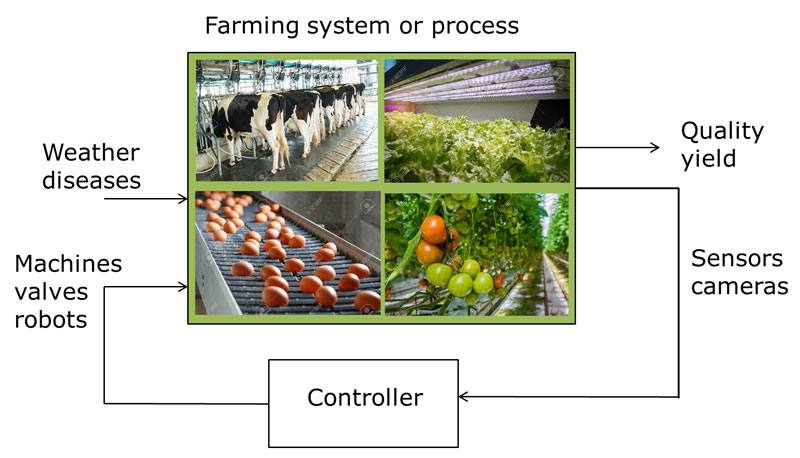by Simon van Mourik, Peter Groot Koerkamp and Eldert van Henten (Wageningen Universiteit)
A key challenge in precision farming is complex decision making under variable and uncertain circumstances. A possible solution is offered by mathematical models and algorithms.
The enormous quantities of fertiliser, pesticides, fresh water, and fossil fuels that have been used in modern farming over the last century have had an enormous impact on the local and global environment. Furthermore, resources such as fresh water, phosphate, oil, and affordable labour are getting scarce. This situation is not sustainable, especially given the rapid growth of the world population.
In our group we research precision farming, a farm management approach that uses information and precision technology to address these sustainability issues; firstly by automation to save on labour input, and secondly by precision management to save on resources, and reduce environmental impacts. The term precision in this context reflects accurate dosage of resources, the timing with which they are applied, and sometimes even how these dosages are allocated; for example feeding per individual animal or fertilising at specific field locations.

Figure 1: The feedback control loop projected onto some farming processes (source photos: www.123rf.com).
We apply the precision farming approach in a range of agricultural settings, for example in arable farming, greenhouse horticulture, and livestock farming. Well known applications are milking robots, automated irrigation, air conditioning, and individual cow feeding. However, most aspects of management are not yet automated or precise. Identifying what is the optimal dosage, timing, and allocation is complicated for a number of reasons. The response of crops, animals, indoor climate, or soil, towards application of food, fertiliser, water, and so on, is generally governed by a complex nonlinear response. Some processes respond quickly, such as indoor climate toward air conditioning, and some processes respond slowly, such as the development of crops or livestock. Hence, we deal with multiple time scales. On top of that come several sources of variation – differences between crops, animals, soil properties, weather changes, and disease occurrence to name a few. Our challenge is to design models and algorithms that come up with optimal management strategies under all of these circumstances.
An automated system consists of three key elements; sensing (by sensors or cameras), processing (decision making software based on sensor information and decision rules), and actuation (by operating valves or switches, by machines, or robots). An example of such as system is the climate inside a greenhouse. With sensors the temperature, humidity, light intensity, and carbon dioxide levels are measured, and based on these measurements a processor decides which windows or screens should be opened or closed, whether lights should be switched on, and how much heat should be pumped into the greenhouse. The interaction between the actuator, farming system, sensor, and processor, forms a feedback loop. This interaction resembles one of the core principles within systems and control theory – feedback control.
Control algorithms allow us to design decision rules that are optimal with respect to a chosen performance criterion. This criterion typically weighs costs of input against revenues of output, for example heating and lighting costs against the yield of greenhouse tomatoes. A control algorithm that works well in practice requires a mathematical model that describes all relevant inputs, dynamic states, and measured output of the system, as well as all relevant disturbances coming from outside such as weather changes or sensor noise. This is quite an exercise, but in the end it pays off. For example, we showed that optimal control of greenhouse air conditioning can potentially save up to 47% on heating energy [1].
A big challenge is introduced by sources of variation that are not understood or are hard to measure in practical situations. To unravel the roles of different sources of variation, we carry out uncertainty analyses. For example, during transport about 5-10% of consumption eggs get fractured, at considerable economic loss. We used a Bayesian uncertainty analysis to predict that variation in collisions has far more impact on fracture rates than variation in egg quality [2]. To deal with variation that cannot be explained or controlled, control algorithms are adapted by online parameter tuning based on sensor data. A promising application for this method is pest control that is adapted to specific fields, greenhouses, or as our research showed, barns [3]. Another promising application we are investigating is a controller that steers the timing of harvest per specific greenhouse and per crop type.
Even if full automatic control is not yet feasible, automated decision support in the form of a prognosis, or diagnosis, can already help a farmer considerably. For example, by generating advice for variable input rates of water and fertilizer depending on local field conditions, or by predicting what the consequence of additional carbon dioxide input in the greenhouse will be regarding yield and input costs. Some methods we apply to this end are model integration, state filtering (for dynamic systems), and machine learning algorithms (mostly for static systems).
For a fully automated, and precisely controlled farm, a lot of mathematical and engineering challenges still have to be addressed. For example, we need more accurate input-state-output models for crop and animal systems, and control algorithms that perform reliably under multiple disturbances (such as weather, model errors, variation, and sensor noise). Nevertheless, since the methods of systems and control theory apply so beautifully to the concepts of precision farming, we believe there is a world to gain here.
Link: http://www.fte.wur.nl/
References:
[1] P. van Beveren, et al.: “Optimal control of greenhouse climate using minimal energy and grower defined bounds”, Applied Energy, 2015. 159: p. 509-519.
[2] S. van Mourik, et al.: “Predicting hairline fractures in eggs of mature hens”, Poultry Science, 2016.
[3] M.F. Mul, et al.: “Development of a model forecasting Dermanyssus gallinae’s population dynamics for advancing Integrated Pest Management in laying hen facilities”, Veterinary parasitology, 2017. 245: p. 128-140.
Please contact:
Simon van Mourik
Wageningen Universiteit, The Netherlands
+31 317 481275











